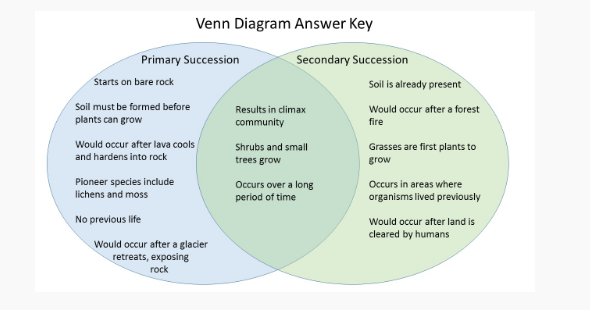Primary and secondary successions are the two types of Ecological succession. An ecological succession is the process of change in the species structure of an ecological community over time. Ecological succession in an ecosystem is caused by disturbances that create new environmental conditions. A disturbance is an ecosystem allows for sunlight, nutrients and habitat to be available for new species to colonize an area.
Primary succession is a process of growth in a region that was previously uninhabited, rocky, unoccupied and there was no vegetation. In primary succession pioneer species such as fungi, algae and fungi as well as other abiotic factors like wind and water begin to stabilize the habitat. Examples of Primary succession include:
- Primary succession after a volcanic eruption (formation of land on the big Island of Hawaii from rock created by lava flows from erupting volcanoes).
- Primary succession in sand dunes.
- Primary succession after a nuclear explosion.
Secondary succession on the other hand, is the process of growth in an area or region after a change in environmental condition (floods, hurricanes, drought or tornadoes) has removed most or all of the species living in the area but has left behind rich soil.
An example of secondary succession is the habitat that is created after a wildfire has damaged an ecosystem. The organic matter left behind after wildfire, provides nutrition and habitat for a new succession of species.
The Difference
- Primary succession takes a long time for completion, it can take 1000 years or more whereas secondary succession takes a less time for completion, it takes between 50 and 200 years.
- Primary succession occurs in a lifeless or an area which has been bare from the beginning whereas secondary succession happens in an area which has been recently got deprived of life and was previously inhibited.
- In primary succession, there is the absence of soil at the starting of the process and the condition is not suitable for sustaining life whereas in secondary succession, the soil is present along with some organisms.
- In primary succession, reproductive structures of any previous occupants are absent in the area whereas in secondary succession, reproductive structures of the previous occupants are present in the area.
- In primary succession, in the beginning the environment is unfavorable whereas in secondary succession the environment is favorable from the beginning.
- In primary succession, pioneer community comes from outside often lichen in a barren rock. In secondary succession pioneer community develops partly from previous occupants and partly from migrants.
- In primary succession, there is absence of humus as there is no soil whereas in secondary succession humus is present from decaying of previous occupants.
- In primary succession intermediary seral communities are more when compared to secondary succession.
Primary Succession Vs. Secondary Succession In Tabular Form
| BASIS OF COMPARISON | PRIMARY SUCCESSION | SECONDARY SUCCESSION |
| Duration | Primary succession takes a long time for completion; it can take 1000 years or more. | Secondary succession takes a less time for completion; it takes between 50 and 200 years. |
| Occurrence | Occurs in a lifeless or an area which has been bare from the beginning. | It happens in an area which has been recently got deprived of life and was previously inhibited. |
| Soil | There is the absence of soil at the starting of the process and the condition is not suitable for sustaining life. | The soil is present along with some organisms. |
| Reproductive Structure | Reproductive structures of any previous occupants are absent in the area. | Reproductive structures of the previous occupants are present in the area. |
| Environment | In the beginning the environment is unfavorable. | The environment is favorable from the beginning. |
| Pioneer Community | Pioneer community comes from outside often lichen in a barren rock. | Pioneer community develops partly from previous occupants and partly from migrants. |
| Humus | There is absence of humus as there is no soil. | Humus is present from decaying of previous occupants. |
Succession Venn Diagram

What Are The Stages Of Primary Succession?
Both primary and secondary succession follows similar stages when becoming colonized by living organisms. The only difference between them is that primary succession requires pioneer species to colonize bare rocks whereas secondary succession requires colonization of an existing but damaged ecosystem. Below are the stage of succession:
Stage 1
Volcano produces bare rock with no organisms.
Stage 2
A pioneer species is any hardy organisms capable of colonizing bare rock. In stage 2, Pioneer species usually lichens begin breaking down the rock. Lichens usually grow on the rock and secrete acids that begin breaking rock into small particles, which mix with lichen remains to begin making soil.
Stage 3
Small complex plants in most cases mosses begin growing when soil is deep enough, after many years, eventually replacing lichens. Also, tiny organisms such as insects come in, add their remains to soil and begin to alter the habitat and soil composition as they colonize the area.
Stage 4
As the soil gets thicker, more complex plants such as ferns, grasses, wildflowers, shrub and small trees begin to move in the area to succeed mosses.
Stage 5
The soil within time become thicker and species such as perennial herbaceous plants, shrubby plants and softwood trees such as pine tree grow in the area become stable and are no longer being replaced. In ecology, this is usually referred to as climax community.